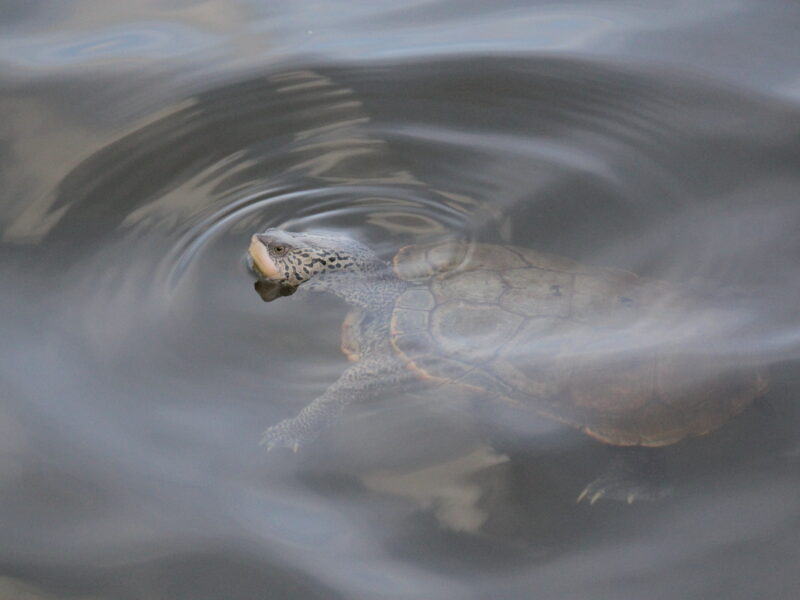
In last week’s Community section, we saw how two preteen girls saved a diamondback terrapin in Sag Harbor in 2018 [“Sisters From Sag Harbor Release Turtle They Found Injured In 2018,” 27east.com, July 7]. The turtle had a badly cracked top shell, the carapace. It was taken to Karen Testa’s Turtle Rescue hospital in Jamesport on the North Fork, where, after four years, it made a slow recovery and had advanced to the point where the turtle was well enough to be taken back to the South Fork and released in Noyac Creek.
The diamondback is the only local turtle that resides in the salty parts of estuaries — males never leave them, while females come ashore to deposit their eggs in the spring, after which they return to salt water. The number of run-overs is extremely high on the roads that are close to the water, such as along the coastal Fire Island and Jones Beach.
It’s only in the 2000s when turtle rescue stations, such as the one in Jamesport run by Ms. Testa, came into being. However, Ms. Testa came from Ginny Frati’s Evelyn Alexander Wildlife Rescue Center hospital in Hampton Bays prior to starting the turtle hospital.
A dryland turtle species, the box turtle is still being run over by motor vehicles on Long Island with impunity. The diamondback lives to be 40 years of age; the box turtle, to more than 100 years.
The female box turtle lays its eggs in shallow depressions scooped out of the earth, then covered with soil and leaves. The box turtles that get squished while crossing roads are mostly females.
Females of another Long Island turtle, the biggest of the lot, the common snapping turtle, are also seen crossing roads during the late spring and early summer. Because of their size, they very rarely get hit by vehicles.
Gravid females leave their home waters after mating, go ashore and lay their eggs, sometimes as far as a half mile or more away from their pond or lake.
The snapping turtle was called “torup” by the local Indians. In Mattituck and several other North Fork communities, torup was the word used to denote this, the largest of our local turtles, commonly, especially by us kids.
Females of the four other Long Island turtles that are also aquatic don’t wander far from their freshwater bases in order to reproduce. The most common of these is the painted turtle, the most ornate of the four. If you see a turtle sunning itself on a partially submerged branch or rock as you drive bay, nine times out of 10 you have been looking at a painted turtle. I can’t think of a pond or lake on Long Island that doesn’t have this species.
If you happen to see a turtle sunning itself or resting on a branch hanging low over the edge of a freshwater pond, you are almost certainly looking at a musk turtle. As their common name indicates, they can smell musky (all other Long island turtles are practically odorless). While they don’t compete for sunning spots with the painted turtle, they often climb into shrubs to stay dry.
Two quite rare turtles on Long Island are the mud turtle and the spotted turtle. The latter has a carapace with a yellow spot in the middle of each scute. This turtle is peculiar to the East End of Long Island, particularly in little drainage ditches and atypical wetland spots.
The other rare turtle is the mud turtle. I have only seen one in my life, in a Westhampton marsh, but I know where a few others have been seen, such as in Hampton Bays in ponds along Red Creek Road.
Both the spotted and the mud turtle are on the New York State Endangered List. It is a very rare moment, indeed, when one of these two shows up on a Long Island road.
There are other non-native turtles that are doing well on Long Island. When Town Pond in East Hampton Village was cleaned up two years ago, a common turtle observed was the red-eared turtle, about the size of a painted turtle, the head with a distinct red mark at the ear. This turtle is the most common pet store turtle in the United States — no wonder it is so common on Long Island.
One might ask about the protection of turtles in New York? Only the snapping turtle may be taken with the proper permit in hand. Sea turtles that come up from the South in the Atlantic Ocean and all native turtles are protected by law.